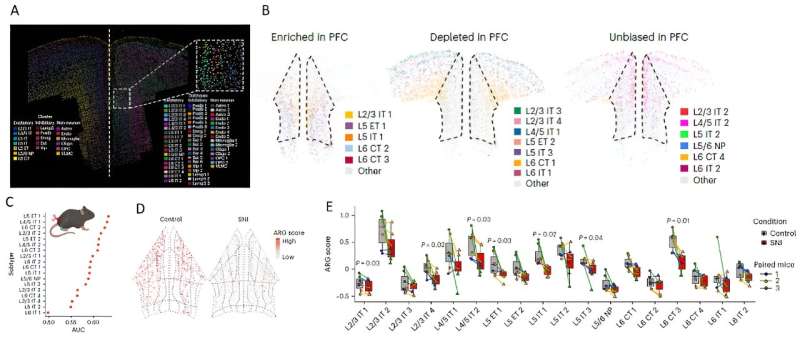November 8, 2023 feature
This article has been reviewed according to Science X's editorial process and policies. Editors have highlighted the following attributes while ensuring the content's credibility:
fact-checked
peer-reviewed publication
trusted source
proofread
Study unveils organizational complexity of the prefrontal cortex and neuron subtypes regulating chronic pain

The prefrontal cortex (PFC) is one of the most sophisticated regions of the mammalian brain. This crucial brain region is known to support various complex functions, including cognition, memory, decision-making, intelligence, and the experience of pain.
Researchers at Boston Children's Hospital and Harvard Medical School recently carried out a study aimed at better understanding the organization of the mammalian PFC using spatial transcriptomic techniques. Their paper, published in Nature Neuroscience, outlines the organization of the mouse PFC more in depth and identifies neuronal subtypes that regulate chronic pain.
"We wondered: how can the PFC regulate so many different functions, while many other parts of cerebral cortex process only a single specialized functions such as hearing, vision, and movement?" Yi Zhang, one of the researchers who carried out the study, told Medical Xpress.
"Our previous single cell RNA sequencing studies have revealed that PFC neurons are molecularly heterogenous. We thus hypothesized that different PFC neuron subtypes may participate in regulating different functions. However, our previous study couldn't reveal the spatial/anatomical organization of the various neuron subtypes and could not integrate the molecular and cellular features with the projection circuits to associate them with specific functions."
The primary objective of the most recent study by Zhang and his colleagues was to create a more detailed projection map of neuron subtypes in the mammalian PFC, while also exploring their role in the regulation of pain. Chronic pain is a widespread issue affecting countless patients worldwide and better understanding its neural underpinnings could ultimately help to develop more effective treatments.
"To address our research question of interest, we employed a spatial transcriptomics approach," Zhang explained. "We used Multiplexed Error Robust Fluorescence In Situ Hybridization (MERFISH), an imaging-based technique that detects the precise location of each RNA molecule within each cell in a tissue slice, through multiple rounds of imaging using fluorescently labeled DNA probes."
The techniques used by the researchers allowed them to map neurons in the PFC based on the expression of more than 400 genes, including cell type markers, functionally significant genes and genes situated in different layers of the cortex. Zhang and his colleagues ultimately combined the molecular properties of neurons they observed in the mouse PFC with findings gathered in previous neuronal tract tracing studies. This allowed them to identify specific neuronal subtypes that project onto the striatum, hypothalamus, amygdala, midbrain, and other brain regions, to in turn build a detailed map of neural circuits.
"We then employed an established mouse model of neuropathic pain to identify transcriptional changes in each of and every neuronal subtype under a state of chronic pain, using MERFISH," Zhang said. "We found that the PFC has a distinct molecular and cellular composition relative to its adjacent cortical regions that regulate movement, touch etc., which corroborate with PFC's specialized functions."
Zhang and his colleagues found that specific combinations of neuron subtypes in the PFC project onto different brain regions to regulate different behaviors. In addition, the team identified one region of the midbrain, the Peri-aqueductal gray (PAG) region, that projects to the spinal cord to regulate pain-related information.
Notably, this brain region was found to receive input from a single neuronal subtype, called L5 ET 1, which is situated in the fifth layer of the PFC. By identifying this specific subtype of PFC neurons and the brain region they project to, the team shed light on how the mouse brain (and potentially also the human brain) regulates pain.
"Chronic pain inflicted the highest transcriptional impact on the L5 ET 1 neurons and also significantly reduced electrical activity in these cells," Zhang said. "This reduced activation is also similar to human PFC under chronic pain state- and thus trans-cranial stimulation of PFC can induce pain relief in humans."
The comprehensive map created by Zhang and his colleagues greatly improves the understanding of the PFC and its neuronal subtypes. In addition to informing the development of new pharmacological treatments for chronic pain, the researchers' recent findings could eventually contribute to the study of various psychiatric disorders, including addiction, PTSD, OCD, bipolar disorder, and schizophrenia.
"In our next studies, we hope to understand the cell type-specific downstream regulatory mechanisms of the different PFC target regions (like PAG, thalamus and amygdala) and how those are orchestrated to generate the sensory and affective deficits characteristic of chronic pain," Zhang added. "We also plan identify the cell type and circuit specific transcriptional and epigenetic changes during chronic pain that can serve as potentially druggable targets (like ion channels or GPCRs in distinct regulatory subtypes)."
More information: Aritra Bhattacherjee et al, Spatial transcriptomics reveals the distinct organization of mouse prefrontal cortex and neuronal subtypes regulating chronic pain, Nature Neuroscience (2023). DOI: 10.1038/s41593-023-01455-9
© 2023 Science X Network





















